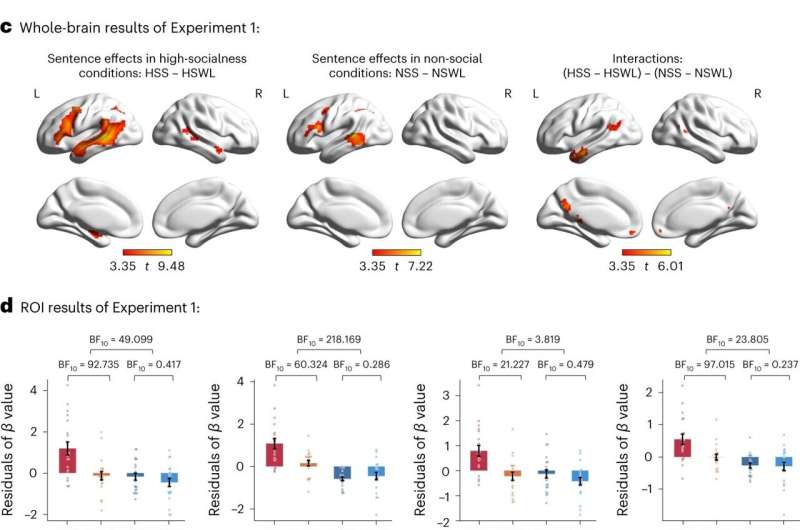This article has been reviewed according to Science X's editorial process and policies. Editors have highlighted the following attributes while ensuring the content's credibility:
fact-checked
peer-reviewed publication
trusted source
proofread
Social vs. language role: Researchers question function of two brain areas

A research team led by Prof. Lin Nan from the Institute of Psychology of the Chinese Academy of Sciences found that during sentence processing, the neural activity of two canonical language areas—the left ventral temporoparietal junction (vTPJ) and the lateral anterior temporal lobe (lATL)—is associated with social-semantic working memory rather than language processing per se.
The study was published in Nature Human Behaviour.
Language and social cognition are two deeply interrelated abilities of the human species, but have traditionally been studied as two separate domains. Both sentence processing and social tasks can evoke neural activity in the left vTPJ and lATL, suggesting that the function of these regions may link language comprehension with social cognition.
However, previous studies have attributed the activity of these regions in language tasks to general semantic and/or syntactic processing, whereas their activity in social tasks is attributed to social concept activation.
In this study, the researchers tested a novel hypothesis that the activity of the left vTPJ and lATL in language and social tasks are both due to a common cognitive component—i.e., social-semantic working memory.
Using fMRI experiments, they validated that these regions were sensitive to sentences only if the sentences conveyed social meaning. In addition, these regions showed persistent social-semantic-selective activity after the linguistic stimuli disappeared and were sensitive to the sociality of nonlinguistic stimuli. Furthermore, these regions were more tightly connected to the social-semantic-processing areas than to the sentence-processing areas.
The results indicate that the left vTPJ and lATL are not specific to language processing and contribute to language comprehension through social-semantic working memory.
"Since the 1990s, it has been consistently observed that the left vTPJ and lATL are sensitive to sentence processing. Therefore, our findings were quite surprising," said Prof. Lin, corresponding author of the study.
These findings are likely to force a major reconsideration of the functional organization of the cortical language network, and they also make an important new contribution to the field of social neuroscience, according to a reviewer for Nature Human Behaviour.
More information: Zhang, G. et al, A social-semantic working-memory account for two canonical language areas, Nature Human Behaviour (2023). DOI: 10.1038/s41562-023-01704-8. www.nature.com/articles/s41562-023-01704-8





















